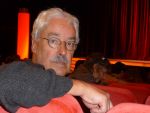 E-mail address: jopaech@aol.com
E-mail address: jopaech@aol.com
Home institution: University of Constance
Academic position: Professor emeritus
Areas of research: theory and history of film and
new media; Intermediality of film, literature and traditional arts
Title of the presentation: Film was never the same
Most important Publications
- ?Passion? oder: Die Ein?bild?ungen des Jean-Luc Godard (Frankfurt 1989)
- Film – Fernsehen – Video und die Künste. Strategien der Intermedialität (Hg. Stuttgart 1994)
- Strukturwandel medialer Programme. Vom Fernsehen zu Multimedia (zus. mit A. Schreitmüller u. A. Ziemer)(Konstanz 1999)
- Menschen im Kino. Film und Literatur erzählen (zus. mit Anne Paech) (Stuttgart 2000)
- Der Bewegung einer Linie folgen … Schriften zum Film (Berlin 2002)
- Intermedialität. Analog/digital. Theorien ? Methoden ? Analysen. (zus. mit Jens Schröter) (Hg. München 2008)
- Warum Medien? (Konstanzer Universitätsreden, UVK 2008)
Title of the presentation
Film was never the same
Abstract
Histories of cinema provide the impression that ?film?, even if it tells new stories or old stories over and over again, has always remained the same. Sound film, color film, Scope- and 3D formats are supposed to be only variants of the same basic apparatus which forms the basis of every history of the film and whose representing technology can be neglected when compared with the represented aesthetics. However, after 100 years of cinema history the fact is not to be overlooked and neglected any more that ?film? today is a product of cinematographic technology for the projection of feature films in the cinema hall.
My presentation will deal at first briefly with four historical and/or theoretical accesses to the inclusion of the technical change into the aesthetic history of film: Barry Salt [1] who describes the influence of technical changes on the (early) aesthetics of the cinematographic film; the French film-structuralism (apparatus theory); [2] Mary Ann Doane [3] who has read anew the film theories critically especially against the background of the technical change; and D.N. Rodowick [4] who sees the identity of ?Film? getting lost in view of the electronic media in the permanent intermedial transmission.
Following this brief survey, my talk will be about some ideas of a media history of film as a multimedia form. The relation between media forms and their aesthetic formulations can be described from the beginnings of film as a constant change. The most serious rupture is that of the transition from mechanical to electronic film or from cinema to television and video with an ostensible continuation of the photographic aesthetic of the film. Today analog and digital technologies interact at all levels of film production, distribution and the ?usage? of films. If today film is any recording and reproduction of moving images in the most different media then what is NOT film? If interactive computer games or live transmissions of football matches are not based on film, is the repetition or rerun of play scenes during their transmission ?film? again? Maybe ?film? is only one special format of recorded (repeatable) multimedia moving images. And in the end, what can be still the subject of actual film theories (as Rodowick asks)?
